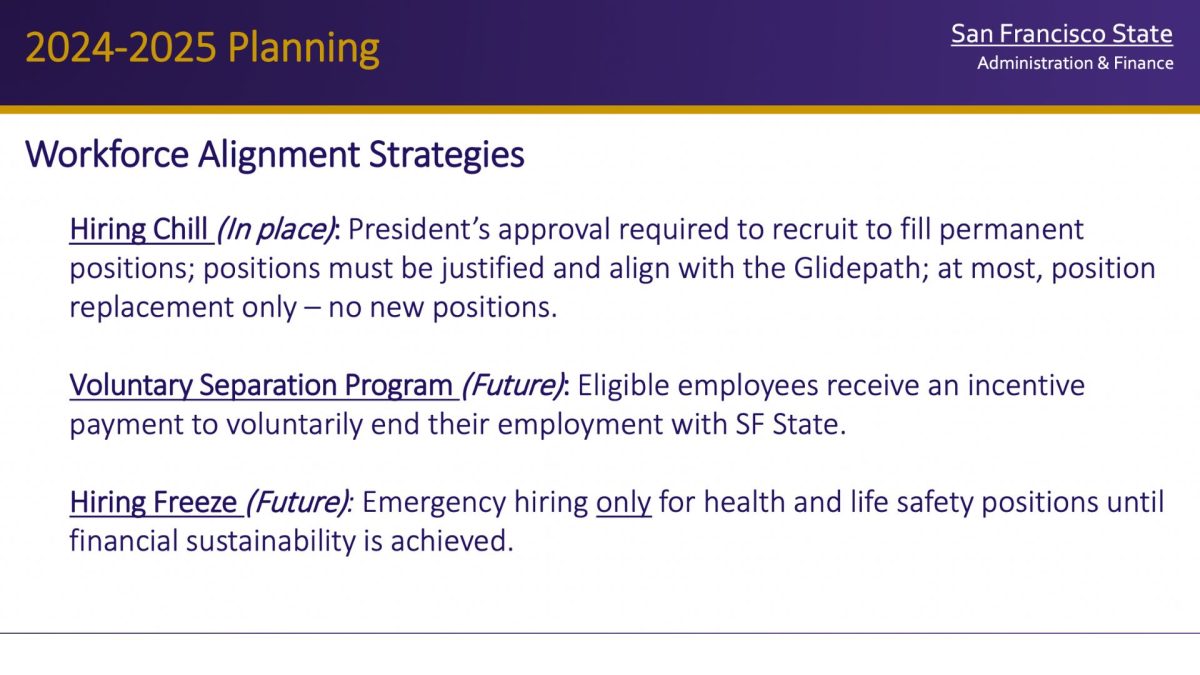The University Budget Committee met on Sept. 21 for the first time since the California State University Board of Trustees voted to approve a multi-year tuition increase, addressing the effects of the tuition hike on students and introducing the possibility of a voluntary separation program for staff.
“We are considering a voluntary separation program which allows eligible employees to receive an incentive payment to voluntarily end their employment with SF State,” said Jeff Wilson, vice president of Administration & Finance.
The UBC meeting discussed the voluntary separation program, which is part of a larger workforce alignment plan and has a goal of offboarding 80 full-time-equivalent employees and creating $8 million in savings, according to Wilson.
The meeting also included SFSU President Lynn Mahoney addressing the committee for the first time since the tuition increase was approved. Mahoney said there was a need for the tuition increase, citing the impact long-term underfunding has had on SFSU staff.
The university already has a “hiring chill” that has been in place since 2020 and is part of the workforce alignment strategy. Wilson says that this strategy slows down hiring in attempts to implement cost savings by hiring only position replacements and not hiring for any new positions.
“There is a gap between what it costs to run the California State University and what we get from the state and collect in tuition,” Mahoney said. “The lack of funding has come at the expense of our staff, who are paid at a minimum of 12% below what people of comparable institutions are paid.”
Mahoney also spoke about how the tuition increase will affect students, maintaining she does not believe the increase will prevent students from enrolling.
“No student will not enroll at San Francisco State or fail to persist at San Francisco State because of $342,” Mahoney said.
However, some students do not agree with Mahoney’s assessment and are already feeling the impact.
“The financial changes within the school have already affected me, even with the tuition increase not implemented yet,” said Natalie Velez, a kinesiology major. “I used to have a full ride on grants alone due to my income and higher grades. However, now I have debt. The tuition increase will only further expand that debt.”
Mahoney addressed students in an email following the meeting for the first time since the California State University Board of Trustees voted to approve a 34% tuition increase by the 2028-29 academic year.
“I assure you that we are working hard to help you find ways to afford your academic journeys, including state-supported on-campus housing, scholarships and targeted philanthropic efforts,” Mahoney wrote.
The help is not felt by every student, as described by Jovan Macias, an international business major. “For four years, I’ve heard claims of helping students, but for the time I’ve been here, I’ve not once seen her be proactive on any issues we really need help on,” Macias said.
Mahoney urged that she will continue to support proper funding and that students will get the financial support needed to continue with their studies.
“We will continue to work to advocate for adequate funding for the transformative education we provide,” Mahoney wrote. “Please know that we are all here to support and assist you.”
Some feel that Mahoney doesn’t understand the impact the increase has on students’ lives.
“President Mahoney only sees the surface of having to pay an extra few hundred dollars, but under that veil, there are students who sacrifice sleep, meals, and time to work for those few extra hundred dollars,” Macias said.
Some students look to Mahoney to do more to stand alongside them.
“It doesn’t seem as genuine because she’s not going through this. If she wanted to be against it [the tuition hike], she could fight with us, but she isn’t,” Jasmine Melendez, a broadcast and electronic communication arts major, said.
Students are not just concerned about the larger payment, they are also aware of other repercussions to employees at the university.
“The tuition increase is not the problem for me,” Macias said. “It’s the greed, corruption, and the immorality of underpaying employees and staff that come to campus to support students, while the people in her [Mahoney’s] position seem to do nothing but take everything.”
The implementation of the voluntary separation process still has a procedure before it can be introduced, according to Ingrid Williams, associate vice president of human resources at SFSU.
“The cabinet must still approve the voluntary separation plan,” Williams said. “Notice must be provided from the Chancellor’s Office to the unions to allow the bargaining units the opportunity to meet and confer over any reasonably foreseeable impacts.”
The announcement and implementation will then roll out to the larger campus.
If the “hiring chill” and voluntary separation program both do not meet the financial goals — which include $8 million in savings — a hiring freeze could then be put in place, only allowing for emergency hiring, according to Wilson.
“The last resort, and the last thing we would want to do, is layoffs,” he said.
The decision regarding the voluntary separation program will be announced this fall after unions have been noticed and the university meets its collective bargaining obligations.
The tuition increase begins in fall 2024, raising costs for undergraduate students by 6%.











